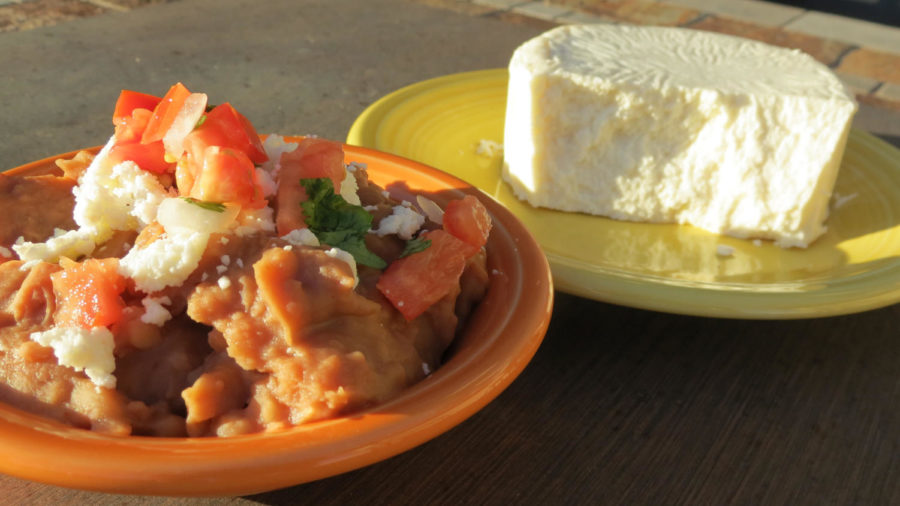All things cheese: Learn flavors, uses of different cheeses
October 1, 2013
Cheese lovers, you have come to the right place. For information about different types of cheeses, their perfect complements, creative ways to eat them and more, check out the list below.
Blue: Blue cheese is known for its unique color; the cheese itself contains blue and green “veins” that develop from mold when the cheese is aged.
Texture, flavor, color: crumbly, creamy; tangy; creamy ivory with blue and green veins
Fat type: medium (8 grams per ounce)
Uses: crumbled on top of salads (Cobb salad), blue cheese dressing/dip, paired with bread, crackers or fruit
Complements: apples, pears, stone fruits, walnuts, honey, port or red wine
Brie: This cheese is named after the French region, Brie, from where it originated. A soft, rich, creamy cheese, it makes for a great dessert fresh or baked.
Texture, flavor, color: soft, creamy; rich, mild to pungent taste; pale yellow
Fat type: medium (8 grams per ounce)
Uses: spread on a turkey and cranberry sandwich, topped with a sweet chutney, mixed with salad greens, candied nuts and balsamic vinegar
Complements: melons, berries, grapes, sun-dried tomatoes, sparking wine or champagne
Cheddar: Wisconsin is the top producer of cheddar cheese in the United States (hence the Green Bay Packers “cheese heads” for you football fans). It is also one of the most popular cheeses around the world.
Texture, flavor, color: smooth, firm; sharp nutty flavor; golden
Fat type: medium (9 grams per ounce)
Uses: soups, sauces, paired with crackers, sprinkled on top of steamed vegetables or baked potato, grilled cheese
Complements: apples, pears, tomatoes and onions, red wine, pale ale, stout beer
Feta: One of the most famous Greek cheeses, feta cheese comes in many varieties, such as black pepper, tomato and basil, garlic, and more.
Texture, flavor, color: firm, crumbly; salty, tart; chalky white
Fat type: medium (6 grams per ounce)
Uses: sprinkled on top of Greek pizza or salad, tossed with shrimp, tomato sauce, and pasta, baked inside spanakopita
Complements: olives, seafood, pasta, mixed greens, chicken, olive oil, nuts, roasted red peppers, pitas, fruit or vegetables, pinot noir, pinot gris, sauvignon blanc
Gjetost: Pronounced, “yay-toast,” this Scandinavian goat cheese is very sweet and is Norway’s national cheese.
Texture, flavor, color: smooth, creamy; sweet, caramel-like; golden orange
Fat type: medium (8 grams per ounce)
Uses: served with jam on rye bread or crackers, eaten on a sandwich
Complements: fruit, jam and jelly
Goat: Goat cheese is a healthier alternative to other types of cheeses since it is lower in both calories and fat. Made from goat’s milk, it has a unique, tangy flavor.
Texture, flavor, color: soft, creamy; tangy; ivory white
Fat type: medium fat (8 grams per ounce)
Uses: spread on a bagel or English muffin instead of cream cheese, bake in a quiche, use on flatbread or Mediterranean sandwiches
Complements: honey, fruit, fresh fig, smoked salmon, tomato, spinach, basil, wine
Gorgonzola: This cheese originates in northern Italy and is one of the oldest blue-veined cheeses.
Texture, flavor, color: crumbly, semi-firm; sharp, tangy; creamy ivory with blue veins
Fat type: medium (8 grams per ounce)
Uses: sprinkle on top of salad greens with sliced fruit and balsamic vinaigrette, stuffed into dried fruit, served with crackers or bread
Complements: whole grain bread/crackers, pears, apples, apricots, figs, nuts, honey, fish, dessert wine, zinfandel, merlot, pinot noir
Gouda: Gouda is named after a village in Holland that shares the same valley with the town of Edam (“edam” cheese). It is made with whole milk and is coated with red wax.
Texture, flavor, color: creamy, smooth; buttery, nutty; pale yellow
Fat type: medium (8 grams per ounce)
Uses: melted in casseroles, partnered with meat inside of a sandwich, providing richness to soups and sauces
Complements: whole grain bread/crackers, poultry, pork, apples, pears, grapes, nuts, dried fruit, chardonnay, champagne, scotch, brandy, pale ale
Mozzarella (fresh): In Italy, fresh mozzarella cheese is made from the milk of a water buffalo. It is often packaged in water in order to retain texture and taste.
Texture, flavor, color: soft, semi-elastic; mild, milky; creamy white
Fat type: medium (6 grams per ounce)
Uses: Served in a caprese salad with fresh tomatoes, chopped basil leaves, and drizzled with olive oil, placed on a baguette sandwich
Complements: pizza, sandwiches, sun-dried tomatoes, basil, olive oil, oregano, red peppers, spinach, chardonnay, sauvignon blanc, pinot grigio
Parmesan: Parmesan, the king of cheeses, is a favorite among worldwide cheese connoisseurs and Americans alike.
Texture, flavor, color: granular; buttery, nutty; pale yellow
Fat type: medium (7 grams per ounce)
Uses: sprinkled freshly grated Parmesan on top of pasta, salad, soup
Complements: pasta, cream and tomato sauces, walnuts, plums, vegetable soups, red wine, dessert wine
Ricotta: Ricotta is a low-fat, high protein cheese that was originally produced from the whey that remained after Mozzarella and Provolone cheese was made.
Texture, flavor, color: creamy yet grainy; mildly sweet; creamy white
Fat type: low (2 grams per ounce)
Uses: cannoli filling, stuffed inside pasta, baked into lasagna
Complements: pasta, herbs, vegetable casseroles, tomatoes, Sauvignon Blanc







